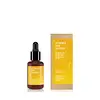What's inside
What's inside
 Key Ingredients
Key Ingredients

 Benefits
Benefits

 Concerns
Concerns

No concerns
 Ingredients Side-by-side
Ingredients Side-by-side

Water
Skin ConditioningPropanediol
SolventGlycerin
HumectantAcacia Senegal Gum
MaskingLithops Pseudotruncatella Callus Lysate
Skin ConditioningCichorium Intybus Root Extract
MaskingSaccharomyces/Grape Ferment Extract
Skin ConditioningZea Mays Oil
EmulsifyingDaucus Carota Sativa Root Extract
Skin ConditioningCyamopsis Tetragonoloba Gum
Emulsion StabilisingPentylene Glycol
Skin ConditioningHelianthus Annuus Seed Oil
EmollientXanthan Gum
EmulsifyingLactic Acid
BufferingSodium Citrate
BufferingSodium Phytate
1,2-Hexanediol
Skin ConditioningCaprylyl Glycol
EmollientPhytic Acid
Ascorbyl Palmitate
AntioxidantPotassium Sorbate
PreservativeSodium Benzoate
MaskingWater, Propanediol, Glycerin, Acacia Senegal Gum, Lithops Pseudotruncatella Callus Lysate, Cichorium Intybus Root Extract, Saccharomyces/Grape Ferment Extract, Zea Mays Oil, Daucus Carota Sativa Root Extract, Cyamopsis Tetragonoloba Gum, Pentylene Glycol, Helianthus Annuus Seed Oil, Xanthan Gum, Lactic Acid, Sodium Citrate, Sodium Phytate, 1,2-Hexanediol, Caprylyl Glycol, Phytic Acid, Ascorbyl Palmitate, Potassium Sorbate, Sodium Benzoate
Water
Skin ConditioningAscorbyl Glucoside
AntioxidantPropanediol
SolventGlyceryl Caprylate
EmollientGlycerin
HumectantTocopherol
AntioxidantCyamopsis Tetragonoloba Gum
Emulsion StabilisingPentylene Glycol
Skin ConditioningGlyceryl Undecylenate
EmollientGlycine Soja Oil Unsaponifiables
EmollientHelianthus Annuus Seed Oil Unsaponifiables
EmollientSodium Phytate
Xanthan Gum
EmulsifyingCitric Acid
BufferingSodium Citrate
BufferingPotassium Hydroxide
BufferingWater, Ascorbyl Glucoside, Propanediol, Glyceryl Caprylate, Glycerin, Tocopherol, Cyamopsis Tetragonoloba Gum, Pentylene Glycol, Glyceryl Undecylenate, Glycine Soja Oil Unsaponifiables, Helianthus Annuus Seed Oil Unsaponifiables, Sodium Phytate, Xanthan Gum, Citric Acid, Sodium Citrate, Potassium Hydroxide
Ingredients Explained
These ingredients are found in both products.
Ingredients higher up in an ingredient list are typically present in a larger amount.
Guar gum is made from the guar bean, a plant native to India. It is considered a form of polysaccharide and naturally contains sugar.
This ingredient is often used to thicken a product or create a gel-like consistency.
It also has emulsion properties to help keep ingredients together.
Learn more about Cyamopsis Tetragonoloba GumGlycerin is already naturally found in your skin. It helps moisturize and protect your skin.
A study from 2016 found glycerin to be more effective as a humectant than AHAs and hyaluronic acid.
As a humectant, it helps the skin stay hydrated by pulling moisture to your skin. The low molecular weight of glycerin allows it to pull moisture into the deeper layers of your skin.
Hydrated skin improves your skin barrier; Your skin barrier helps protect against irritants and bacteria.
Glycerin has also been found to have antimicrobial and antiviral properties. Due to these properties, glycerin is often used in wound and burn treatments.
In cosmetics, glycerin is usually derived from plants such as soybean or palm. However, it can also be sourced from animals, such as tallow or animal fat.
This ingredient is organic, colorless, odorless, and non-toxic.
Glycerin is the name for this ingredient in American English. British English uses Glycerol/Glycerine.
Learn more about GlycerinPentylene glycol is typically used within a product to thicken it. It also adds a smooth, soft, and moisturizing feel to the product. It is naturally found in plants such as sugar beets.
The hydrophilic trait of Pentylene Glycol makes it a humectant. As a humectant, Pentylene Glycol helps draw moisture from the air to your skin. This can help keep your skin hydrated.
This property also makes Pentylene Glycol a great texture enhancer. It can also help thicken or stabilize a product.
Pentylene Glycol also acts as a mild preservative and helps to keep a product microbe-free.
Some people may experience mild eye and skin irritation from Pentylene Glycol. We always recommend speaking with a professional about using this ingredient in your routine.
Pentylene Glycol has a low molecular weight and is part of the 1,2-glycol family.
Learn more about Pentylene GlycolPropanediol is an all-star ingredient. It softens, hydrates, and smooths the skin.
It’s often used to:
Propanediol is not likely to cause sensitivity and considered safe to use. It is derived from corn or petroleum with a clear color and no scent.
Learn more about PropanediolSodium Citrate is the sodium salts of citric acid. In skincare, it is used to alter pH levels and acts as a preservative.
Its main functions are to maintain the pH of a product and neutralize metal ions.
The acidity of our skin is maintained by our glands and skin biome; normal pH level of skin is slightly acidic (~4.75-5.5).
Being slightly acidic allows our skin to create an "acid mantle". This acid mantle is a thin barrier that protects our skin from bacteria and contaminants.
Learn more about Sodium CitrateSodium Phytate is the synthetic salt form of phytic acid. Phytic acid is an antioxidant and can be found in plant seeds.
Sodium Phytate is a chelating agent. Chelating agents help prevent metals from binding to water. This helps stabilize the ingredients and the product.
Water. It's the most common cosmetic ingredient of all. You'll usually see it at the top of ingredient lists, meaning that it makes up the largest part of the product.
So why is it so popular? Water most often acts as a solvent - this means that it helps dissolve other ingredients into the formulation.
You'll also recognize water as that liquid we all need to stay alive. If you see this, drink a glass of water. Stay hydrated!
Learn more about WaterXanthan gum is used as a stabilizer and thickener within cosmetic products. It helps give products a sticky, thick feeling - preventing them from being too runny.
On the technical side of things, xanthan gum is a polysaccharide - a combination consisting of multiple sugar molecules bonded together.
Xanthan gum is a pretty common and great ingredient. It is a natural, non-toxic, non-irritating ingredient that is also commonly used in food products.
Learn more about Xanthan Gum